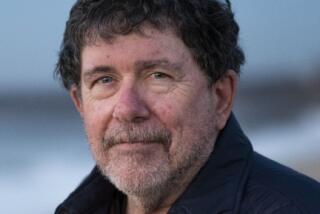ORANGE COUNTY POP MUSIC REVIEW : A Lot of Hush, Too Little Rush for Cowboy Junkies
- Share via
“Shhhhh.”
That’s what was printed on Cowboy Junkies souvenir T-shirts for sale Friday night at the Coach House in San Juan Capistrano, where the Canadian band was making its first appearance in Orange County.
An unusual slogan for a rock band, but one that was true enough: “Shhhhh” pretty well states the method of a group that has won acclaim for bringing a kind of hush back into pop music.
At the Coach House, Cowboy Junkies demonstrated the considerable virtues--but also fell at times into the obvious pitfalls--of restraining sound and emotional expression to the point where they almost seem to be held inside.
The resounding eloquence of quietness has seldom been better illuminated than in the Toronto band’s version of Neil Young’s “Powderfinger.” Played as an encore during the 90-minute early show, the song provided one of those transcendent, unforgettable moments that are a music fan’s Grail.
Young’s original is a full-bore countrified rocker, a classic song with an exploding riff that is one of the signal expressive events in the annals of rock ‘n’ roll guitar.
The Cowboy Junkies played “Powderfinger” as a quiet, Appalachian-flavored folk ballad.
It featured mandolin and an accordion that turned the rawness of Young’s original riff into caressing softness that gave comfort to Margo Timmins’ tremulous yet dignified singing.
Thus muted and stripped down, the Cowboy Junkies’ inspired interpretation got to the psychological and narrative core of “Powderfinger,” a mythic song about a young man confronting something beyond his experience, something that can’t be comprehended, much less controlled. In the song, the youth acts on instinct and feeling, challenging that mysterious something--a sinister gunboat--and dying in the attempt.
Timmins’ fitting dedication to “the people in the streets of China” added to the deep grace and emotional tug of the song. (What’s really incomprehensible is how some swine in the audience could yell “Party!” midway through this pearl.)
The Cowboy Junkies’ muted approach was not always appropriate, such as their failed attempt at the Rolling Stones song “Dead Flowers,” about someone lashing out fearsomely over romantic rejection. In the original, making a wrongdoing lover bleed with mocking words was not nearly enough for Mick Jagger. He was going to dope himself with heroin as well, as if defiant self-destruction would be the ultimate revenge.
A staid reading that turned “Dead Flowers” into a routine country lament hardly did those raging emotions justice. Some feelings just can’t be expressed quietly.
When the delicate, wistful-looking Timmins sings, the words sound like thoughts drifting and flickering in a bone-weary mind that is barely resisting sleep. Sometimes, that sad and pretty internalized voice was just right: On meditative songs such as “Misguided Angel” and “30 Summers,” Timmons sifted through deep wells of thought and emotion, evoking a profound sense of love strained and embattled. But at other times, as sameness of vocal tone set in, the listener’s attention drifted.
This would have been a widely uneven show if Timmins’ talent was the crux of Cowboy Junkies. But the band’s essence is really the wonderfully responsive and inventive instrumental work of the six men playing behind Timmons on a stage decorated by candles flickering in shallow glass holders.
Restraint was the watchword instrumentally as well as vocally. But Cowboy Junkies’ interactive ensemble playing led to shifts and shadings of tone and small surges in dynamics that introduced a fine, low-key energy into most of the songs. A few quietly smoldering blues songs early in the show were especially effective.
But at any given point, whether the song was based in blues, folk or country music, something inventive and lovely was happening: a perfectly placed mandolin shimmer, fiddle weave or sharp but muted harmonica cry from multi-instrumentalist Jeff Bird; a bit of pretty accordion embellishment from Jaro Czerwinec; a spare solo or gently twanging rhythm part from guitarist Michael Timmins, Margo’s brother.
Kim Deschamps’ pedal steel guitar work was a special pleasure. As a soloist, he summoned understated, mysterious dread during the Robert Johnson blues “Me and The Devil,” and applied a strange, mad meander to Patsy Cline’s “Walking After Midnight.” Playing with the ensemble, Deschamps seemed to dab on just the right hues, for just the right durations, as he took the pedal steel guitar far beyond its standard honky-tonk sighs and keens.
As a front woman, Margo Timmins was charismatic in her introverted way. Clinging to her microphone stand with both hands, she seemed deep in reverie.
Timmins snapped out it enough between songs to display a wry sense of humor, but the wan tone in her speaking voice maintained a distance.
By making an audience want to be drawn in, so that the distance can be bridged with concentrated listening, Cowboy Junkies achieved something unusual and fine. But if “Shhhhh” turns out to be more dogma than jest, something that sounded fresh the first time could easily turn into something pretentiously ascetic.
It would not be a bad sign if, the next time around, Cowboy Junkies souvenir stands sport T-shirts that say, “Let It Rock.”
More to Read
The biggest entertainment stories
Get our big stories about Hollywood, film, television, music, arts, culture and more right in your inbox as soon as they publish.
You may occasionally receive promotional content from the Los Angeles Times.











